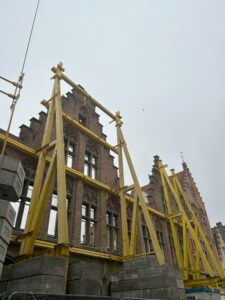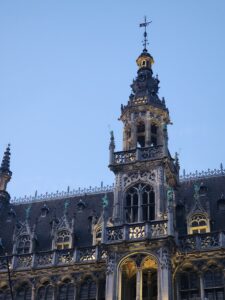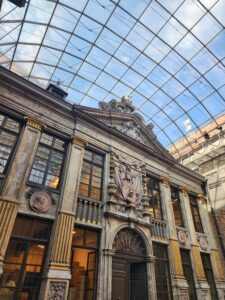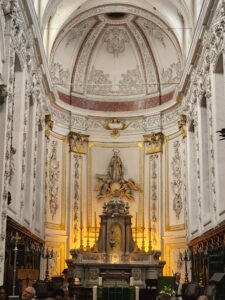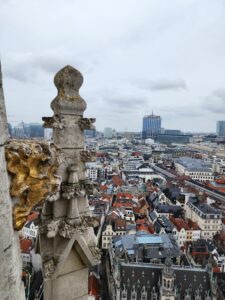Day 1 – 10/09/2024
Unfortunately, our first day in Amsterdam was only a short evening (we arrived at 8 pm), as we spent the day travelling from Cologne, Germany to the Netherlands on a 5-hour bus ride. As we came from Germany, we got to see quite a bit of the Dutch countryside (under the pelting of rain, typical) as we drove from the eastern part of the country to just a bit inland of the North sea coastline.
We arrived at the Amsterdam Sloterdijk Station in the northwestern part of the city, where we then jumped onto the metro to get us to our home for the next 5 days, which was a hostel located in the Noorderpark neighbourhood. Just a little bit outside of the historical center of Amsterdam, across the River IJ, the northern neighbourhood had a residential feel with masonry townhouses, some larger apartment complexes and small shops. Our hostel located right at the heart, being a rehabilitated church with a restaurant, bunks and full private rooms for the hostel residents, a library, and seating/working areas littered throughout. Staying outside the main urban center gave us a chance to see another part of the city, which we would have never explored originally.



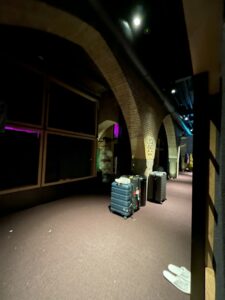
Day 2 – 11/09/2024
Our first proper day in Amsterdam! As we headed straight to our hostel the night before this was our first chance at seeing the city in its full glory, arriving at the historic center’s main station called “Amsterdam Central”. Walking out from the north side of the station we got an amazing view of the IJ river, and the massive glass canopy stretching across the entirety of the station. Built in the late 20th century, the station’s glass roof stands as a great example of engineering with an expansive roof structure covering part of the internal station and exterior path, and is an iconic historical landmark of the city. Exiting through the south side of the station we got a view of the infamous canals, but also the front facade of the station constructed in the late 19th century, featuring gothic and renaissance revival styles both within and along the masonry facade, and using 8687 wooden piles for its foundation!


We didn’t have much of plan for our first day but to explore Amsterdam-Centrum (inner most borough of the city) and the famous UNESCO designated world heritage canals from the 17th century. The construction of these canals was the largest large-scale town planning project of its time that created a beautiful city design and landscape.
The city felt pretty chaotic walking through with bikers, cars, trams, and pedestrians, we felt like we had to turn our heads every which way and make sure we wouldn’t get decked by a bike. As someone visiting the city it was difficult to get with the flow of all the traffic, but its great to see biking prioritized in the city’s urban planning.


Some of our highlights of the day included of course the canals, it felt never ending walking through the city. We both loved “Miffy” (the stuffed bunny, originally from the Netherlands and around every corner and shop). And the tiny one person cars! Other highlights included the row apartments, the integrated nature along the streets with the massive trees, and people sitting along the canals providing some small peaceful pockets in the busy city.






Day 3 – 12/09/2024
For our second full day, we spent it visiting some main landmarks, doing some thrifting, and traversing through the city and it’s canals. We left our church turned hostel, the Bunk, exploring around our neighbourhood, Noord. There were some lovely parks and courtyards within the winding masonry townhouses of the neighbourhood, providing some green spaces for the residents. We also dropped off a load of laundry at a laundromat, then made our way into the city!




First we stopped at the ‘Rijksmuseum’ which opened in 1885, and is the national museum of the Netherlands dedicated to Dutch arts and history. We walked around the exterior, under the main passage, and explored the gardens. Within the passage – the tunnel space that runs through the ground level of the structure – was built with vaults. The decorated metal tie-rods that support the arches were quite outstanding, as typically metal tie rods are quite small, trying to appear invisible when spanning an arch.


We then tried getting tickets for the Van Gogh museum, which is right by the Arts museum, but realized we had to get tickets in advance. We compromised with Van Gogh themed ‘Miffy’ crochet keychains, but we were definitely a bit disappointed we didn’t get to visit. We then walked through the canals and explored the many thrift and stationary stores, and some quirky stores as well in the city. While also stopping for some coffee/hot chocolate and snacks along the way.






We also stopped at the “The Begijnhof”, which we also visited a similar one in Burges, but was intended as something closer to a nunnery or dedicated residential courtyard for women. Men were not allowed within the courtyard and the women would work together to create a self-sufficient community as a group dating back to the 14th century.


We passed by the Zuiderkerk, also known as the “southern church”, which is a 17th-century (as shown by the 1614 on the clock tower) protestant church in the Nieuwmarkt area. We didn’t need directions making our way to this church as it stood out along the rooflines of the city.


We returned to our neighbourhood, visiting a playground, while we waited for our laundry. Then headed home after stopping by and petting each cat that we passed, and had an evening in working on our travel journals in the beautiful library of our hostel. The hostel in which we stayed was an adaptive reuse project of the St. Rita Church, which was originally built in the 1920s. It was cool to see how they transformed a church into such a vibrant and active space that holds a hostel, restaurant, library, and recording studio.




Day 4 – 13/09/2024
Our final full day in Amsterdam, we again visited some important landmarks and tried to explore some more unknown neighborhoods of the city. But first, to get to the metro station that takes us into the city we walked along a small section of the canal within our neighbourhood.


Once in the city our first stop was the Anne Frank House. It was surreal to see the house that holds such a rich history and impactful story in person.
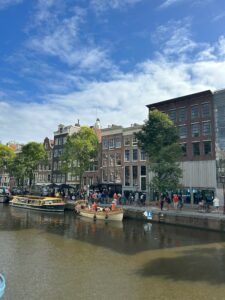

Nearby was the “Westerkerk” church, which was quite simplistic on the inside with painted white walls and grayish-brown ceilings, and minimal ornamentation with gold detailing. The church was built between 1619-1631, and is the largest church in Amsterdam. The tower was completed 7 years (1638) after the initial construction and stands at 85m tall, towering over the city. The renaissance style of the church meant that, in contrast to the gothic arches we often saw during our trip, renaissance architecture commonly used semi-circle arches. That was seen through the arched windows and the barrel vault ceilings. We were lucky when we visited the church with beautiful light streaming in from the many windows, and a very small orchestra practicing under the organ.




We then headed to a boat canal tour starting near central station and taking us through the historic center by waterway. We learned about the history of the city, it’s buildings and of course the canals! We also enjoyed some Dutch wine and cheese on the side. An interesting fact from our tour: The widths of building facades vary greatly depending on which neighbourhood your passing through in the city. This is due to a 16th century law in which the authorities imposed a building tax based on the width of a property’s canal frontage. This means that you can tell that the wider building fronts were owned and built by the wealthier residents of the city.




We then walked around the northwestern part of the city, enjoying our last meal at “Blin Queen”, with some pancakes. Met a few dogs, including a wiener dog whose owner needed us to watch his bike for 2 minutes while he ran inside a store, and cute dog in a raincoat. Found a 1€ bathroom within a nail salon with the nicest ladies working there, it was a life saver. Passed by another famous church called the Zuiderkerk (again!). We also passed through a large section of Chinatown, going into quite a few shops.



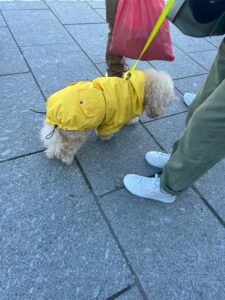
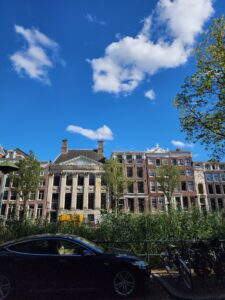



We couldn’t help but notice a common quirk about buildings in Amsterdam being that many buildings appear to be slanted, or settling on one side, but remain standing! This is due to the fact that their foundations were built on wooden piles that have since experienced or are currently experiencing deterioration. This can cause differential settlement where the buildings begin to crack and tilt in funky ways.


We returned back to our hostel within the Noord neighborhood leaving from the Amsterdam Central station, passing by our usual cats, and enjoying the last fall evening in the quaint neighborhood. It felt like the perfect end to our stay in Amsterdam, and great way to end our trip!




Day 5 – 14/09/2024
This was the last official day of our trip where we parted ways, and was the official close to our three weeks of travel in Northwestern Europe! Liz returning back to Fredericton, Canada and Kate heading to Kortrijk, Belgium to visit a close friend.

Elizabeth: “My last day in Europe. I’ve never had an experience like this before. I had the opportunity to explore so many wonderful and historically rich cities. I’ve learned so much about heritage conservation from these travels and gained an even deeper appreciation for heritage preservation.”
Kate: “This trip was absolutely amazing! Although I’ve been in Europe for grad school this past year, getting the opportunity to truly travel, exploring new cities and countries the past three weeks was something else. Having a great travel buddy, and supportive team at OWHC truly made the trip something I won’t forget.”
We want to thank @ovpm_owhc_ocpm for this wonderful opportunity to explore Northwestern Europe, and their helpful and kind team: @moni_loves_heritage and @_f.forster! Words cannot express our gratitude!
Stay tuned for our creative output that OWHC will be presenting on their online collection and exhibition!
You can read our more detailed travels and discussion in our Instagram posts here!
Thank you for the amazing trip.





























